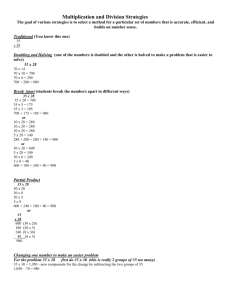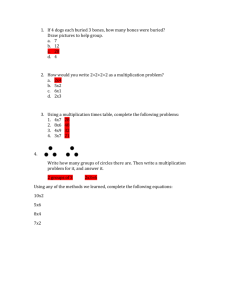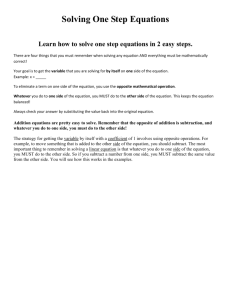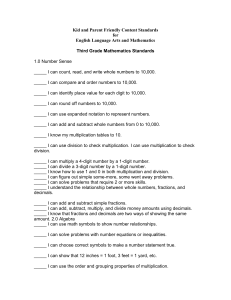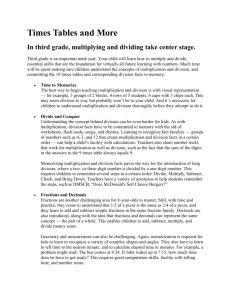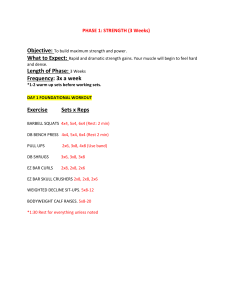All children can learn the basic multiplication facts
advertisement
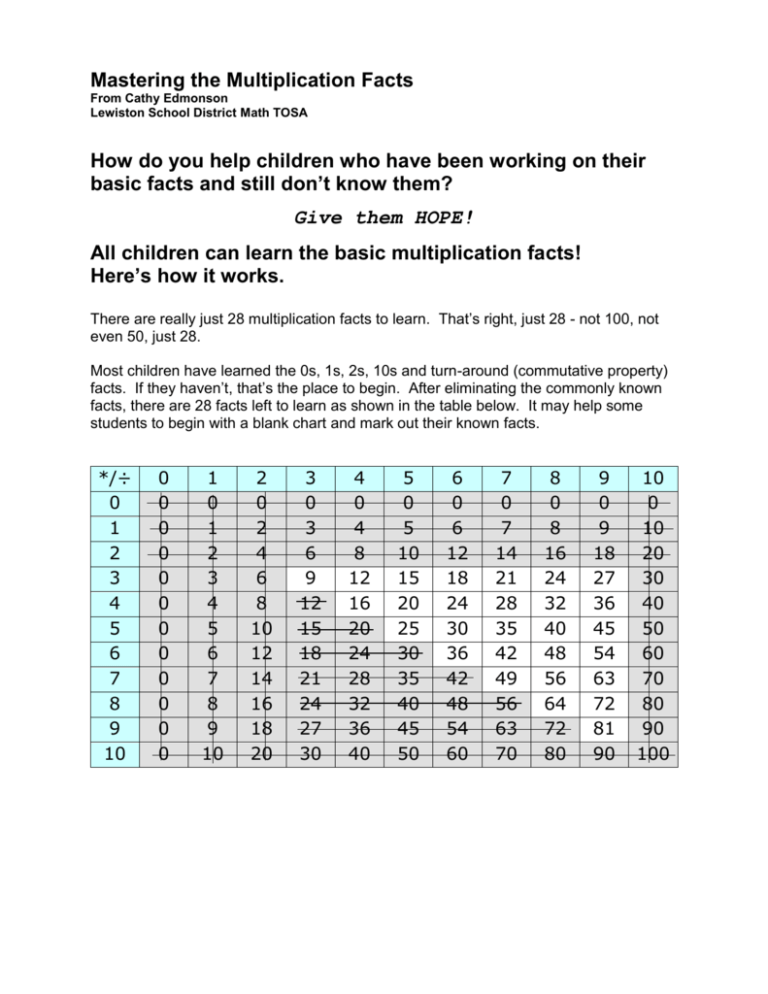
Mastering the Multiplication Facts From Cathy Edmonson Lewiston School District Math TOSA How do you help children who have been working on their basic facts and still don’t know them? Give them HOPE! All children can learn the basic multiplication facts! Here’s how it works. There are really just 28 multiplication facts to learn. That’s right, just 28 - not 100, not even 50, just 28. Most children have learned the 0s, 1s, 2s, 10s and turn-around (commutative property) facts. If they haven’t, that’s the place to begin. After eliminating the commonly known facts, there are 28 facts left to learn as shown in the table below. It may help some students to begin with a blank chart and mark out their known facts. */÷ 0 1 2 3 4 5 6 7 8 9 10 0 0 0 0 0 0 0 0 0 0 0 0 1 0 1 2 3 4 5 6 7 8 9 10 2 0 2 4 6 8 10 12 14 16 18 20 3 0 3 6 9 12 15 18 21 24 27 30 4 0 4 8 12 16 20 24 28 32 36 40 5 0 5 10 15 20 25 30 35 40 45 50 6 0 6 12 18 24 30 36 42 48 54 60 7 0 7 14 21 28 35 42 49 56 63 70 8 0 8 16 24 32 40 48 56 64 72 80 9 0 9 18 27 36 45 54 63 72 81 90 10 0 10 20 30 40 50 60 70 80 90 100 Facts with Understanding When an approach to fact mastery involves making sense along with memorization, students are usually successful and have a way to “think” of the answer if they forget a fact. There are many thinking strategies for the facts. In fact, any fact can be derived from a known fact. Here are some suggestions that are “tried and true.” The following sequence shows how a student can go from needing to learn the 28 facts to knowing all of them. Ways to learn the remaining facts: The 5’s can be learned with skip counting (21 left to learn) 5x3, 5x4, 5x5, 5x6, 5x7, 5x8, 5x9 The square numbers seem to be easily visualized with a square array and then seem to be more easily remembered (15 left to learn) 3x3, 4x4, 6x6, 7x7, 8x8, 9x9 The 4’s (11 left to learn) It’s like two of the 2’s (double the 2’s) For 4x3 I think 2x3=6 and another 2x3=6 and 6+6=12 For 4x6 I think 2x6=12 and another 2x6=12 and 12+12=24 For 4x7 I think 2x7=14 and another 2x7=14 and 14+14=28 For 4x8 I think 2x8=16 and another 2x8=16 and 16+16=32 The 6’s (9 left to learn) (If I know my 5’s I can get the 6’s) I want to know 6 x 7so I think 5 x 7 = 35 so 6 x 7 = 42 I want to know 6 x 8 so I think 5 x 8 = 40 so 6 x 8 = 48 The 3’s (6 left to learn) (skip count or “I know my 2’s so it’s one more group”) 3x6, 3x7, 3x8 7x8 This is (5x8)+(2x8) or 40+16=56 (5 left to learn) The 9’s (I know my 10’s so I can get my 9’s) 3x9 is 3x10 subtract 3 4x9 is 4x10 subtract 4 6x9 is 6x10 subtract 6 7x9 is 7x10 subtract 7 8x9 is 8x10 subtract 8 Celebrate – I know all my facts! Area Model for Basic Multiplication Facts Any fact can be derived from a known fact. Manipulative models can be used. Using linking cubes (borrow from primary if you need to for a short time), build the rectangular array for the fact. Note: not all students need to begin with the manipulatives but some will. It depends on their age and ability to grasp the numbers at an abstract level. The learning progression could be this: concrete pictorial symbolic manipulatives arrays numbers Example: 4 x 8 mental math 8 4 Ask, “How might we break this apart into parts we know?” Students might suggest breaking the 8 into 4 and 4. 4 4 4 It then becomes (4x4) + (4x4) which is 16 + 16 which is 32. They might also suggest breaking the 8 into 5 and 8. 5 3 4 It then becomes (4x5) + (4x3) which is 20 + 12 which is 32. They might also suggest starting with 5x8 instead of 4x8. 8 5 5 x 8 is 40 4 but I really just need 4 x 8 so I have 8 too many. If I take 8 from 40 I end up with 32. With numbers it would look like this: (5x8) – (1x8) which is 40 – 8 which is 32. The student could do several different models and then decide which one is quickest and easiest for them. Instructional sequence: 1. Develop understanding of multiplication first. (It is important that memorization follows understanding.) 2. Teach the 0s, 1s, 2s and 10s. Test them and document that they are learned. 3. Pretest the basic 28 facts. 4. Make cards on missed items (have the kids do this). 5. Assist students in developing clues that will help them “know” the fact from some other fact they already know. See suggestions above. 6. Practice sorting facts by strategies. Then use the desired strategy to get the answer. 7. Drill and practice with flashcards at home and school. Begin with a few at a time (3 or 4 would be good – not more than 7 at a time) 8. Give a practice test and celebrate improvement. 9. Continue systematically using strategies and strategy selection until all are learned. In no time at all, the facts will be mastered. 10. Celebrate! 11. Occasionally review the 28 facts.
